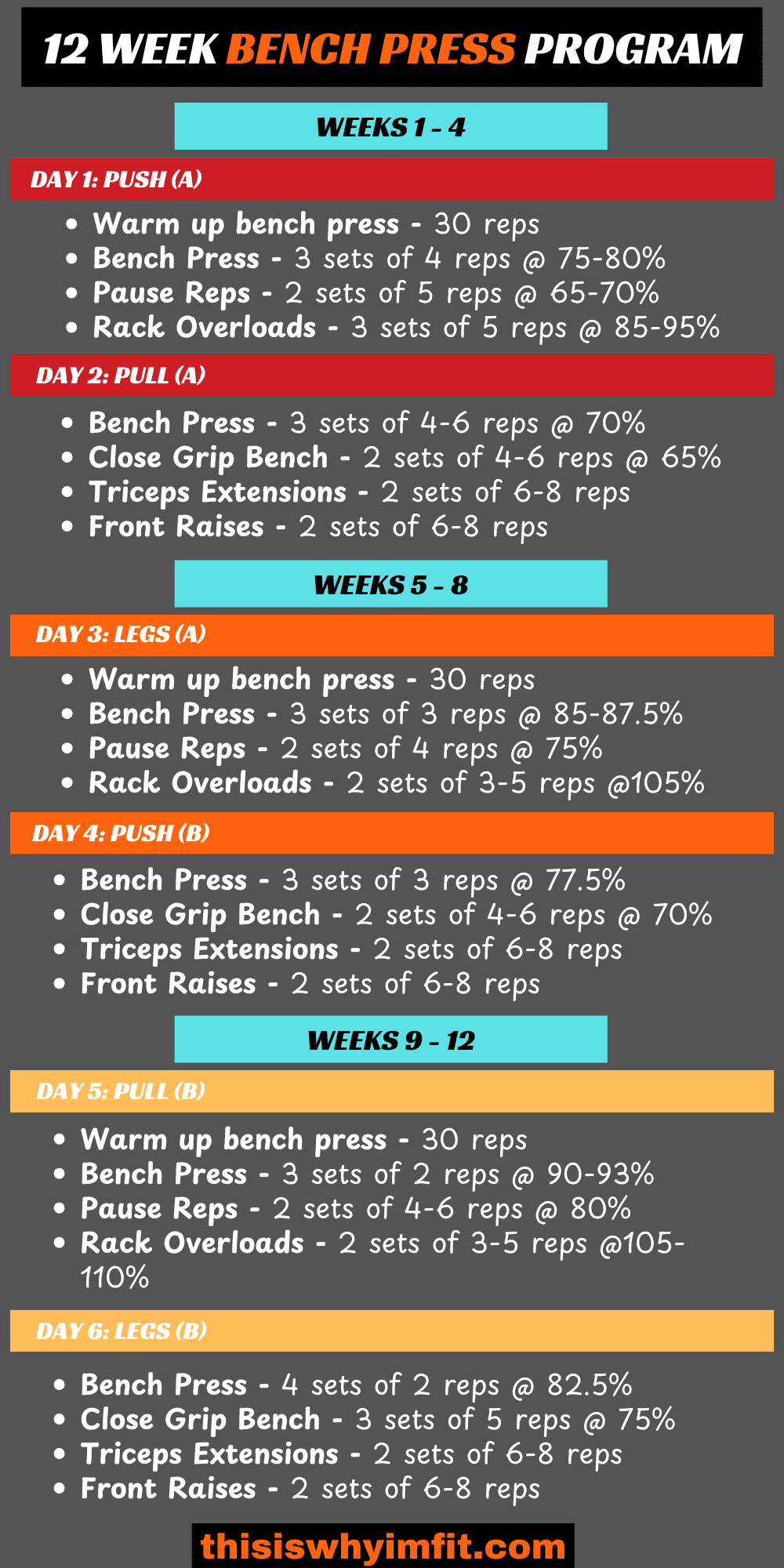
The best online fitness resource you'll ever need. We filter out the BS to ensure you meet your health and fitness goals!

The best online fitness resource you'll ever need. We filter out the BS to ensure you meet your health and fitness goals!
Boost your bench press with this 12 week bench press program designed to increase your 1RM, break plateaus, and build serious strength. Free PDF included!

Almost everyone who’s ever lifted weights has, at some point, looked for the perfect bench press program to help them push more weight.
The bench press is the universal test of strength—the lift that gets the most attention and respect in any gym.
But for all the hype, most lifters have no idea how to actually improve their bench.
They grind away, adding weight randomly, stalling out, and wondering why their numbers won’t budge.
That’s where our 12-week bench press program comes in. It’s a structured, proven plan designed to break through plateaus and increase your one-rep max (1RM).
The routine is based on solid research and a program I followed years ago—one that helped me boost my 1RM by 20% in preparation for an open powerlifting meet in Texas.
I learned this approach from elite US powerlifters—guys who didn’t just lift heavy but won competitions. I didn’t win. Not even close. But my bench got stronger, and yours will too.
If you’re serious about stacking plates and pressing more weight, this bench press program is the one to follow. Let’s get to work.
Jump to the program now!
Alternatively, you can download the free PDF version of the routine using the link below:
| Program style | Resistance Training |
| Workout duration | 1-2 hours |
| Scheduling | 2 days a week |
| Goal | Improve bench press 1RM |
| Level | Beginners to advanced |
| Target Gender | Male and Female |
Bench press is a skill lift. It is technique-dependent. Picking the right grip and setting up (i.e., proper distance from the rack, back arch, etc.) make a big difference.
Now, here’s where I need to add the truth bomb:
Bench press is not a requirement for having a big chest, or for general physical fitness.
Related: If you want a bigger chest, try our Big Chest Workout Program.
There are smart people who say that you have to bench 1.5X your bodyweight to be considered fit.
This is utter nonsense.
Some people are not built to barbell bench. Folks with long arms, narrow shoulders, and flat rib cages struggle with it.
Yet those same people rock at dumbbell or cable chest flyes.
A great many people learn to hate the gym because the “mandatory” lifts are difficult for them.
Don’t be a prisoner to a specific lift.
If you want to grow your bench, the program here will help.
This max bench program spans 12 weeks, 3 months. You’ll be working out your bench 2 days a week. I suggest a 3rd day that you devote to posterior shoulder work.
Day 1 will be your heavy day. It does not need to be done on Monday.
Day 2 will be a comparatively lighter day weight-wise but aimed at building muscle mass. You’ll still be working hard, applying progressive overload.
Insert 2 or 3 rest days between Days 1 and 2. You may find that you need 3 days between Day 2 and the next week’s heavy Day 1. If that’s the case, 2 days between Days 1 and 2.
Make sense?
Here’s a table to illustrate an example schedule:
| Day | Split |
|---|---|
| 1 | Heavy Day |
| 2 | REST |
| 3 | REST |
| 4 | Light Day |
| 5 | REST |
| 6 | REST |
| 7 | REST |
The point here is that you need to be fully recovered from Day 2 for the Day 1 to follow. If you find that you’re not, back off Day 2’s workload a bit.
More is not better.
You’re going to need to do a little math. Start with your previous best bench, your 1 Rep Max.
Your max should be the weight you can lift using pristine form, and that means all the rules of competition apply:
For your own 1 RM you don’t necessarily need someone to signal you to lift off your chest, but you do need to pause about a second to demonstrate control.
Bouncing the bar off your chest doesn’t count.
That rep just described will represent 100% for the rest of these equations. Calculate all your training percentages off this previous 1 RM.
If it’s been a while since you attempted a max heavy single, you’ll need to do that.
Pick a day when you’re rested and well-fed to give yourself a fighting chance of setting the right baseline… in other words, your 1RM.
Use Our Calculator!
If you already know what you can bench for a given number of reps (not 1 rep obviously) you can use our in-house 1 RM Max Bench Press Calculator to estimate what your 1RM should be!
Now, set your training target. What you want your new 1 RM to be.
If you’ve been training for a while, your increases are going to be incremental, nothing spectacular.
If you’re new to lifting, your new 1 RM may be appreciably more than previous maxes.
But for sake of explanation, follow this example:
Let’s say you’re experienced and your previous 1 RM was 300 lbs (132kg).
Your target personal best is 315. That’s some pretty easy math. 5% increase.
At those amounts, you *could* base all your percentages off 95% of personal best, but 95% of 315 is 299, so you might as well make it easy on yourself and calculate off the previous 1 RM.
The concept is the same: you’ll build up to and beyond what you were previously able to lift.
No detailed explanation needed. The variables are your grip width.
The regulation grip is that the handles cannot be outside the ring that’s cut into the bar (knurling). Hands can be well “inside” the ring, just not outside.
Because a regulation bench requires control and a brief pause at chest level, it makes a lot of sense to train that bottom-most portion of the exercise.
Exaggerating the pause to 2, maybe even 3, seconds, will build strength you’ll need for your new max lift.
Alright, these are straight-up incredible, and the logic behind doing them is so freaking smart.
I learned these from a guy named Tim Jackson when I was in college. (Hey Tim, wherever you are!)
You’ll need a power rack or squat rack for these.
Here’s how to set it up:
Later in the program, you’ll be raising the safety bars so that they’re high, near the top of your range of motion, i.e. near lockout.
At this phase, you’re going to train your central nervous system to get used to what that heavier-than-ever weight feels like.
Load the bar beyond what you’d be able to lift though a complete range of motion. Perform 3 to 5 reps.
This is the magic. So much of performance lifting is neuro-muscular. Once your brain and spinal cord “learn” what heavier feels like, your muscles will follow.
There are 2 benefits to doing a close grip as part of your workout. For one, close grip tends to bias the triceps and anterior delts more than a wider grip.
Both those muscles play major roles in a strong bench.
A bodybuilding favorite and great for strength training also. Cables preferred. Pick the attachment of choice and go to work.
If you have no cable machine available, EZ Curl or barbell skull crushers, or JM presses work too.
The Smith Machine–if you have one handy–also is great for JM presses also.
Dumbbells or Cables, either works. For building a big bench, I’d suggest using the thumbs-up grip for the Front Raises.
The 2nd benefit is that you just might find–as I did–that you’re actually stronger with a narrower grip.
⚠️ Stay away from the gym for 3 to 5 days prior to attempting your new 1 Rep Max. During that time, eat well, and get plenty of sleep.

Download our Bench Press Program PDF below:
We write custom programs. If you have specific physique goals–such as “I’d like wider shoulders”, or “I’d like more ‘V’ in my back”–we can write one for you. Reply in the Comments or simply contact us and we’ll get back in touch. First come, first served.